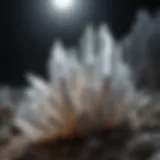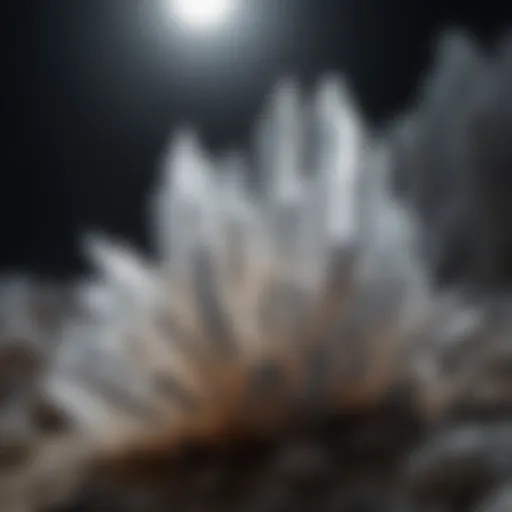Unraveling the Intriguing Secrets of Sand Dollars: A Deep Dive into Their Enigmatic World
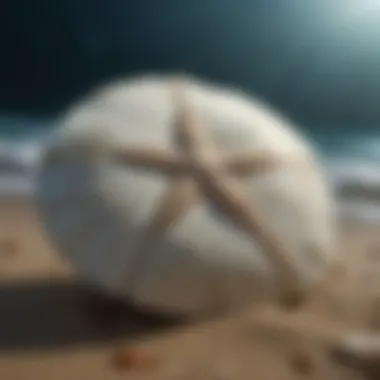

Introduction:
Sand dollars, intriguing sea creatures found along the ocean floors, have long captivated the interest of science enthusiasts and inquisitive minds alike. This article embarks on a journey to unravel the mysteries surrounding these enigmatic organisms, shedding light on their unique characteristics, ecological significance, and cultural symbolism.
Characteristics of Sand Dollars
Sand dollars, often referred to as 'sea cookies' due to their round shape resembling a biscuit, belong to a group of flat, burrowing echinoids. These marine invertebrates boast a hard endoskeleton with a delicate pattern of pentaradial symmetry, making them easily identifiable in the vast ocean landscape. Known for their flattened body covered in tiny spines and hair-like structures, sand dollars play a crucial role in marine ecosystems by aerating the sediments and serving as a food source for various marine animals.
Ecology and Importance
Apart from their distinctive physical features, sand dollars hold immense ecological significance. Their feeding habits, primarily consisting of microscopic algae and detritus, help maintain the balance of nutrients in coastal waters, contributing to the overall health of marine environments. Furthermore, these creatures serve as indicators of water quality, making them valuable assets for environmental monitoring and conservation efforts worldwide.
Cultural Symbolism
In many cultures, sand dollars have garnered symbolic meanings beyond their biological functions. Some view them as tokens of good luck or fertility, while others associate them with themes of unity and connection to the natural world. Their intricate patterns and unique characteristics have inspired myths and legends throughout history, blending science with storytelling to elevate these humble sea creatures to realms of reverence and wonder.
Conclusion
As we delve into the enigmatic world of sand dollars, one thing becomes clear - these seemingly simple organisms carry profound significance in both scientific and cultural contexts. From their role in ecosystem sustainability to their symbolic presence in human history, sand dollars continue to fascinate and inspire curiosity. Join us in exploring further the secrets held by these mysterious sea dwellers.
Introduction to Sand Dollars
Sand dollars, fascinating echinoderms of the Class Echinoidea, hold a significant place in marine ecosystems. Their unique characteristics and ecological contributions make them a compelling subject of exploration in this article. Understanding the role of sand dollars in the intricate web of marine life sheds light on their importance in maintaining ecosystem balance and biodiversity.
Definition and Appearance
Overview of sand dollars
Sand dollars, flat disk-shaped marine invertebrates, showcase intricate designs and patterns on their surface. Their radial symmetry and endoskeleton structure set them apart from other marine life forms. The presence of distinct segments and petal-like patterns contribute to their allure, making them a fascinating study subject within marine biology.
Distinctive features
The key characteristic of sand dollars lies in their flattened body structure, resembling a coin washed ashore. This unique shape aids in their burrowing habits and camouflaging techniques in sandy seabeds. The presence of spines for locomotion and tube feet for feeding highlight their remarkable adaptations to their environment. Despite their delicate appearance, sand dollars showcase remarkable resilience in the face of varying marine conditions.
Taxonomy and Classification
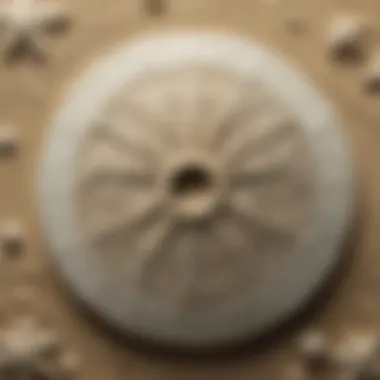

Phylum Echinodermata
Belonging to the Phylum Echinodermata, sand dollars are closely related to starfish and sea urchins. Their elaborately designed exoskeleton composed of calcium carbonate emphasizes their evolutionary connection to marine life forms. Understanding their classification within this diverse phylum provides insights into their evolutionary history and ecological niche.
Class Echinoidea
As members of the Class Echinoidea, sand dollars exhibit key traits such as pentaradial symmetry and tube feet usage for mobility and feeding. Their spherical body shape with a flat underside distinguishes them within this class of echinoderms. Exploring their classification at the class level unveils the intricacies of their anatomical adaptations and ecological role within marine ecosystems.
Habitat and Distribution
Natural habitats
Sand dollars primarily inhabit shallow coastal waters with sandy or muddy substrates, where they feed on organic detritus and microscopic algae. Their preference for calm, wave-protected areas underscores their susceptibility to disturbances caused by human activities such as coastal development and pollution. Studying their distribution in natural habitats unveils the delicate balance required for their survival and reproduction.
Global distribution
Spanning across various oceanic regions, sand dollars exhibit global distribution patterns influenced by water temperature and nutrient availability. From the Pacific to the Atlantic coasts, these echinoderms showcase adaptability to diverse marine environments. Exploring the global distribution of sand dollars sheds light on the interconnectedness of marine ecosystems and the effects of climate change on their habitat range.
Ecological Importance of Sand Dollars
In the grand tapestry of nature, sand dollars emerge as crucial players in marine ecosystems, their significance intertwined with the delicate balance of oceanic life. These enigmatic creatures, with their intricate structures and behaviors, play a pivotal role in shaping their underwater habitats, leaving a lasting impact on the environment. By delving into the ecological importance of sand dollars, we gain insights into the intricate web of relationships that sustain marine life.
Ecosystem Engineers
Role in marine habitats
Sand dollars function as essential components in marine habitats, actively participating in the modulation of their surroundings. Their movements and feeding habits contribute to the circulation of nutrients and sediment, influencing the ecosystem's health. The role of sand dollars in marine habitats is fundamental, serving as indicators of ecosystem balance and health. Understanding their impact sheds light on the intricate dynamics of underwater environments.
Impact on sediment composition
The influence of sand dollars on sediment composition is a critical aspect of their ecological role. Through their feeding activities and burrowing behavior, sand dollars play a significant part in the redistribution of sediment, affecting the habitat's structure and stability. Their interactions with sediment not only shape the physical environment but also impact the diversity of species inhabiting these areas. Exploring the impact of sand dollars on sediment composition unveils the hidden mechanisms that drive marine ecosystems.
Feeding Behavior
Diving into the feeding behavior of sand dollars reveals a fascinating world of dietary preferences and mechanisms that sustain these enigmatic creatures in their underwater realm. Their feeding habits are finely tuned to extract essential nutrients from their surroundings, showcasing a remarkable adaptation to their marine diet.
Dietary habits
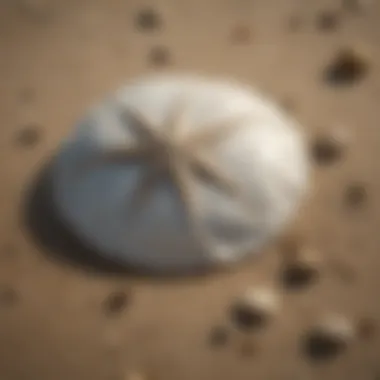

Sand dollars exhibit specialized dietary habits, feeding on organic particles and detritus present in the marine environment. Their selective feeding strategies enable them to thrive in both rich and challenging underwater ecosystems, showcasing their adaptability to varying food sources. Understanding their dietary preferences provides a glimpse into the intricate relationships that underpin marine food webs.
Feeding mechanisms
The feeding mechanisms employed by sand dollars underscore their efficient utilization of available resources. Through intricate anatomical structures and behaviors, sand dollars effectively harvest food particles from the surrounding water and sediment. Their feeding mechanisms not only sustain their individual survival but also contribute to the broader nutrient cycling processes in marine ecosystems.
Predators and Defense Mechanisms
Navigating the realm of predators and defense mechanisms illuminates the adaptive strategies employed by sand dollars to survive in the face of natural pressures. From evading predators to deploying protective adaptations, sand dollars exemplify resilience in the intricate dance of predation and survival in the marine world.
Natural predators
Sand dollars face predation pressures from a range of natural predators, each posing unique challenges to their survival. Whether evading predatory fish or crustaceans, sand dollars have evolved defensive behaviors to mitigate the risks posed by their adversaries. The interactions between sand dollars and their natural predators offer a glimpse into the complex predator-prey dynamics at play in the marine environment.
Protective adaptations
In response to predatory threats, sand dollars have developed a suite of protective adaptations to enhance their chances of survival. From spines and tube feet to camouflage and burrowing behaviors, sand dollars employ a range of tactics to deter predators and safeguard their existence. Exploring these protective adaptations unveils the intricate strategies that underpin the survival of sand dollars in their ever-changing marine habitats.
Reproductive Strategies of Sand Dollars
In the exploration of the enigmatic world of sand dollars, understanding their reproductive strategies plays a crucial role in deciphering their life cycle and population dynamics. The reproductive strategies of sand dollars encompass intricate processes, ranging from spawning to larval development. By delving into these strategies, researchers and enthusiasts gain insights into the sustainability and propagation of sand dollar populations.
Spawning process
The spawning process of sand dollars is a pivotal aspect of their reproductive strategy. This mechanism involves the release of gametes into the water column, where external fertilization takes place. This synchronized release is essential for fertilization and subsequent larval development. The spawning process optimizes the chances of successful reproduction and genetic diversity among sand dollar populations, ensuring their resilience in fluctuating marine environments.
Life cycle stages
Exploring the life cycle stages of sand dollars unveils the stages of development from fertilized egg to adult echinoderm. These stages include embryonic development, larval stages, metamorphosis, and juvenile growth. Each stage is intricately linked, culminating in the formation of mature sand dollars. By examining these life cycle stages, scientists can track population trends, assess reproductive success, and implement conservation strategies to protect vulnerable life stages. Understanding the nuances of the life cycle stages sheds light on the intricacies of sand dollar reproduction and growth.
Fertilization Mechanisms
External fertilization
External fertilization is a key aspect of sand dollar reproduction, facilitating the fusion of gametes in the open ocean. This mechanism ensures genetic diversity by allowing gametes from different individuals to combine. External fertilization enhances the adaptability of sand dollar populations to changing environmental conditions and promotes healthy genetic variations within the population. Despite the risks associated with external fertilization, such as gamete dispersion and predation, this mechanism remains integral to the reproductive success of sand dollars.
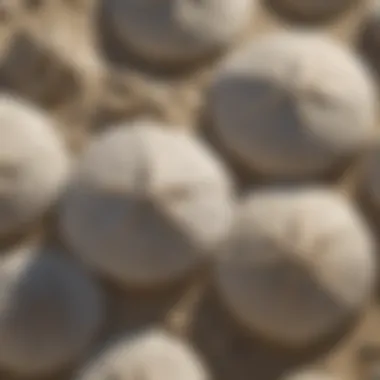

Development of larvae
The development of larvae in sand dollars encompasses a series of metamorphic changes from a planktonic form to a benthic organism. Larval development is a critical phase that determines the survival and settlement of young sand dollars. The successful metamorphosis of larvae into juveniles marks a milestone in the reproductive strategy of sand dollars, ensuring the replenishment of adult populations. By elucidating the development of larvae, researchers can assess environmental influences on larval survival rates and devise measures to safeguard vulnerable stages of the population.
Cultural Significance of Sand Dollars
Symbolism and Folklore
Historical beliefs
Exploring the historical beliefs surrounding sand dollars provides insights into the mystique that shrouds these marine creatures. Throughout history, sand dollars have been associated with various superstitions and interpretations, often symbolizing peace, prosperity, or even spiritual significance. The intricate patterns on their skeletal remains have led to cultural interpretations, with some cultures considering them as tokens of good luck or symbols of religious significance. Understanding the historical beliefs attached to sand dollars enriches the appreciation for their cultural importance.
Modern interpretations
In the context of modern interpretations, sand dollars continue to evoke fascination and symbolism in contemporary culture. From decorative items to spiritual emblems, modern interpretations of sand dollars bridge the gap between tradition and current perspectives. Artists and artisans draw inspiration from the elegant structure of sand dollars, incorporating their motifs into various forms of art. Modern interpretations not only uphold the cultural legacy of sand dollars but also reinterpret their symbolism in a contemporary context, keeping their relevance alive and evolving.
Artistic Inspirations
Representation in art
The representation of sand dollars in art showcases the enduring influence these sea creatures hold in creative endeavors. Artists have long been captivated by the intricate patterns and radial symmetry of sand dollars, translating their beauty onto canvases, sculptures, and decorative pieces. The unique form of sand dollars, resembling delicate sand-etched coins, lends itself well to artistic interpretation, serving as a muse for artists seeking to capture the essence of the marine world in their creations.
Creative adaptations
Creative adaptations of sand dollars transcend traditional artistic boundaries, exploring innovative ways to interpret and reimagine these natural wonders. From abstract reinterpretations to contemporary art installations, creative adaptations challenge conventional perceptions of sand dollars, fostering experimentation and artistic expression. By pushing the boundaries of artistic creativity, these adaptations not only showcase the adaptability of sand dollar symbolism but also invite viewers to explore new perspectives and aesthetics within the realm of art.
Conservation Concerns and Research Efforts
Conservation Concerns and Research Efforts are pivotal aspects in understanding and safeguarding the delicate balance of sand dollar populations. In a world where anthropogenic activities threaten marine ecosystems, the focus on conservation efforts becomes paramount. Research initiatives play a crucial role in identifying key stressors and implementing measures for the preservation of sand dollars and their habitats. By shedding light on the significance of conservation and research, we pave the way for sustainable coexistence with these enigmatic sea creatures.
Threats to Sand Dollar Populations
Habitat destruction
Habitat destruction stands as a potent threat to sand dollar populations, disrupting the natural equilibrium vital for their survival. The degradation of coastal areas due to urbanization, pollution, and coastal developments poses a direct threat to their habitats. The loss of suitable living spaces and sources of food jeopardizes the existence of these fascinating echinoderms. Recognizing the detrimental effects of habitat destruction is imperative in fostering a deeper understanding of the challenges that sand dollars face in the wake of increasing human interventions.
Climate change impacts
Climate change exerts a profound influence on sand dollar populations, altering marine environments and creating unfavorable conditions for their growth and reproduction. Rising sea temperatures, ocean acidification, and extreme weather events impact the delicate physiology of sand dollars, leading to population declines. The repercussions of climate change on these organisms underscore the urgent need for comprehensive strategies to mitigate its effects. By addressing the specific impacts of climate change, we can develop adaptive measures to secure the future of sand dollars amidst global environmental changes.
Scientific Studies and Conservation Initiatives
Research on population trends unveils critical insights into the dynamics of sand dollar populations, enabling scientists to assess changes in distribution and abundance over time. By monitoring population trends, researchers can identify patterns of decline or growth, informing conservation efforts and management strategies. Conservation projects play a pivotal role in translating scientific findings into actionable measures for the protection of sand dollars. Through the implementation of conservation projects, stakeholders collaborate to preserve essential habitats, regulate human activities, and raise awareness about the significance of these intriguing marine creatures. Embracing scientific studies and conservation initiatives is fundamental in cultivating a future where sand dollars thrive in harmony with their marine environments.
